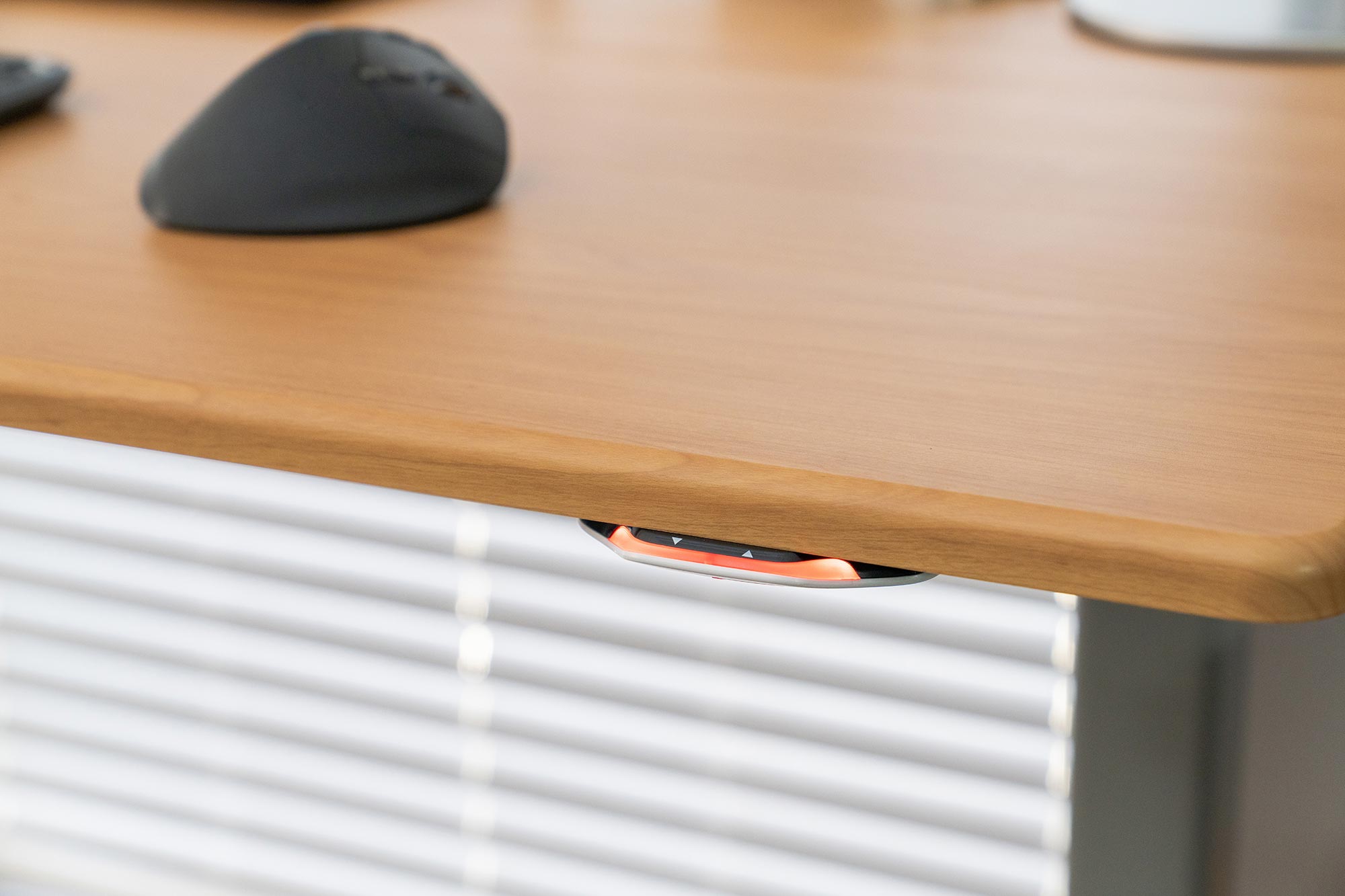Setting Up Your Standing Desk
You’ve finally got your standing desk, and you’re wondering what to do next. Or perhaps you’re waiting for your standing desk to arrive, and you want to get a headstart on better health as soon as it does. Either way, this short guide will help you hit the ground running (or perhaps standing) with your new height-adjustable workstation.
 First, prepare your space. Make sure you have a level surface on which to place the desk. This will ensure that the linear actuators (the legs) of your desk operate at peak efficiency. If your desk is not level, you may find your desk straining and squeaking when elevating, especially when bearing heavier loads. All iMovR desks come with leveling pads installed on the feet. This means that even if your surface is slightly uneven, as most are, you can use the leveling pads to compensate, reducing the strain on the adjustable legs of your desk.
First, prepare your space. Make sure you have a level surface on which to place the desk. This will ensure that the linear actuators (the legs) of your desk operate at peak efficiency. If your desk is not level, you may find your desk straining and squeaking when elevating, especially when bearing heavier loads. All iMovR desks come with leveling pads installed on the feet. This means that even if your surface is slightly uneven, as most are, you can use the leveling pads to compensate, reducing the strain on the adjustable legs of your desk.
Next, you’ll need to assemble the desk (unless you’ve selected the factory pre-assembly option). If your desk requires assembly, we also suggest placing a blanket on the ground to prevent damage to the floor or scratches to the tabletop while it’s upside down.
Instructions are included with your iMovR desk. All iMovR tops are pre-drilled, so you will not need to drill any holes to assemble the desk—the only tool you’ll need is a screwdriver. Depending on your desk, the process should take 5-30 minutes, and it goes even faster with a friend. You can always opt for iMovR’s factory pre-assembly or white glove delivery to skip this step entirely.
Finally, configure your desk to ensure proper ergonomics. It will take some time to get your desk to the correct height for you. Try to set your desktop height so that the top of your monitor is eye-level, and your wrists are not flexed too far upward or downward while typing—your hands should be just slightly angled upwards in relation to your forearms. There’s a lot more to say on ergonomics—please check out our dedicated guides on the subject.
Note for DIYers
If you’re looking to assemble a desk not composed entirely of iMovR parts, you’ll have to put in some additional elbow grease. You’ll probably require a power drill to attach the tabletop to the base. We recommend vacuuming your work area before starting, as well as putting your tabletop on a blanket to protect the finish. Remember not to overload your iMovR base with too heavy a tabletop—the base weight ratings refer to the capacity of the base excluding tabletop.
What about weight rating?
Additionally, while considering your desktop’s setup, you should consider the amount of stuff on your desk in regards to weight rating. Too much clutter is not only distracting but can affect the performance of your desk’s motor as well. Remember that your tabletop does not factor into the weight rating of your base. Then, you’ll have to account for the weight of your computer, monitor and monitor arms, and any other accessories like printers.
Another factor is that objects will likely be unevenly distributed along your desktop, creating what’s known as side-load stress. For instance, your monitor arms are mounted to the back edge of your desk, which creates more stress than objects in the center of the desktop. The weight limit for your desk may be lower if most of the weight is side-loaded. Be cautious as you start to approach the weight limit for your desk, as you may end up reducing the lifespan of the motor in the long run. This issue can be compounded if the desk is not level.
Standing Desk Tips
Standing desks enable you to combat sitting disease and get your work done in a healthier and more productive way. The kicker is that you actually have to stand in order to get the benefits. Most workers are used to spending eight hours a day sitting at work, with additional time spent sitting during their commutes and at home. Standing up for any significant amount of time is going to require a shift in your everyday behavioral patterns, and for some people, even the idea seems scary.
The truth is that it’s really not a gargantuan goal at all. The majority of workers who use standing desks end up continuing to use them not just for their proven health benefits, but also because they simply feel good. As is the case with all change, you may not like it at first, but we’re confident that you’ll like this one if you give it a chance. Here are some tips to make sure you don’t quit before you really get started:
1. Start slow
If the idea of standing for eight hours a day seems daunting, fear not—you don’t have to (and in fact, doing so can cause health problems.) Start with just an hour a day of standing while working, either broken up into two half-hour sections or all at once. You can increment up by five minutes per day until you get to two sessions of two hours each. At that point, you’ll cut your sitting time at work by half, assuming an eight hour day. You can continue to increment from there until you find the perfect amount for you. It’s also crucial to remember to change between positions (sitting, standing, or walking) every two hours or less, encouraging blood flow so you can kick your sedentary habits to the curb.
2. Ensure proper ergonomics
Working while standing is going to feel pretty awkward if your setup is not ergonomically configured—and even worse, a bad setup can lead to health problems like carpal tunnel in the long run. There’s a lot more to say on the topic, but here’s a quick rundown of key points to make sure your workstation isn’t working against you:
- The top of your monitor(s) should be about at eye-level
- Your hands should be close to level with your forearms
- Your upper arms should rest closely to your body, while your lower arms should be bent forward at the elbow, ideally not all the way to 90 degrees
- You should be standing up straight, not hunched over
The goal is to keep your muscles at rest and prevent strain as much as possible by working from a neutral position. To achieve this, your keyboard should ideally be placed with front side (closer to you) being higher than the back. Accessories like monitor arms or a SteadyType™ Keyboard Tray are essential in achieving an ergonomic setup.
3. Use a standing mat
 One of the most frequently cited problems of first-time standing desk users is foot pain. When you’re standing in one place for a long period of time, standing mats are the best way to keep your feet comfortable. iMovR’s Ecolast Premium line of standing mats are made of 100% polyurethane at .75” thickness, a clinically proven formula to reduce fatigue and foot pain associated with standing while improving posture to boot. It’s amazing the difference a good standing mat can make.
One of the most frequently cited problems of first-time standing desk users is foot pain. When you’re standing in one place for a long period of time, standing mats are the best way to keep your feet comfortable. iMovR’s Ecolast Premium line of standing mats are made of 100% polyurethane at .75” thickness, a clinically proven formula to reduce fatigue and foot pain associated with standing while improving posture to boot. It’s amazing the difference a good standing mat can make.
4. Accessorize
In addition to standing mats, iMovR offers several other accessories to make the road to better health simple and smooth.
- Monitor arms are the key to keeping your monitor at eye level. If your monitor isn’t high enough, you’ll constantly be looking down, eventually leading to neck pain.
- Your computer, monitors, and standing desk all need to plug into electrical outlets, plus any additional electronic accessories that may reside on your desktop. It’s easy for your cables to quickly become a mess. iMovR offers two cable management kits to help keep your workstation tidy.
- You don’t have to give up your storage space in pursuit of a healthier workstation—the iMovR Mobile File Cabinet lets you retain your under-desk storage in a finish that will match your desktop.
5. If you’re tall, get height extenders
It’s impossible to achieve an ergonomically sound workstation when your desk isn’t high enough. iMovR is unique among standing desk manufacturers in that we go out of our way to accommodate taller standing desk users. When you’re using a treadmill, you instantly add 5” of height, which requires you to change your setup for proper ergonomics. Our desks go all the way up to 50.5”, plus available height extenders, accommodating users up to 6’2”.






